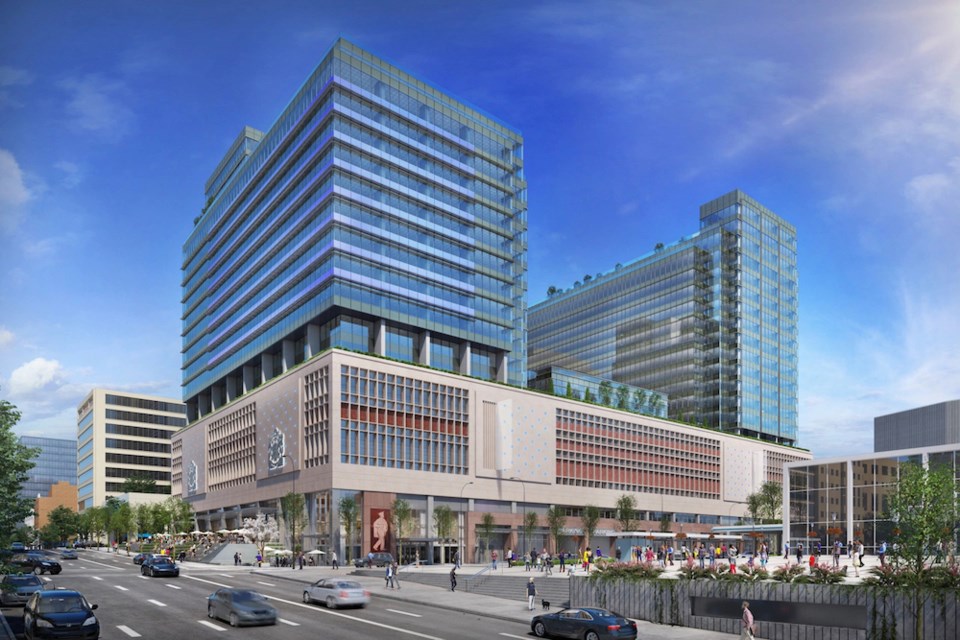Strong absorption in both the office and industrial market is keeping B.C. real estate humming despite economic worries.
Third-quarter stats from Colliers International indicates that uptake of office space in Metro Vancouver slowed to 214,808 square feet in the third quarter, pushing vacancies down to 5.8 per cent, while industrial absorption strengthened to 1.5 million square feet driven by new offerings that lifted vacancies from their historic lows to 0.2 per cent.
Demand for office and lab space by tech companies including Abcellera Biologics Inc., Omnisolu Technology Inc. and Archiact Interactive Inc. drove activity in both the Vancouver and Victoria markets.
“They seem to be on a growth curve,” said Susan Thompson, associate director of research at Colliers. “Yes, we have heard of some budget cuts and layoffs, but that’s not consistent across the board. We’ve also got a number that are growing and expanding. There still seems to be demand, and of the active tenant mandates out in the market looking for space, 34 per cent downtown [in Vancouver] is from the tech sector.”
Tech companies will be among the firms taking space in new developments later this year, the fulfilment of earlier commitments but also bringing fresh activity to the downtown Vancouver market. These include Amazon’s occupancy of south tower at The Post, 349 West Georgia Street, which will add 517,375 square feet to the downtown inventory.
“Amazon saw huge growth, obviously, during the pandemic, thanks to e-commerce, and that’s maybe backed off in the last little while, but we’re seeing a lot more demand for technology and equipment, analysis, lab work in the healthcare-life science sector because it’s become a lot more important,” Thompson said.
While the Vancouver market has several options available to life science companies, strong demand has put pressure on the short supply of lab space in Victoria, where office vacancies average 5.9 per cent.
The industrial market offers even fewer options, with almost any space quickly snapped up. While rising construction costs and slowing demand prompted PC Urban to hit pause on IntraUrban Cornerstone, a 167,000-square-foot strata industrial development in Langford, absorption in the third quarter has been high.
“Rents have increased in Q3 and will likely continue to climb for the remainder of 2022. Users will likely want to still get their foot in the door sooner rather than later, because nobody knows when or even if a price reduction will come. Cash is still king and continues to help offset the increased cost of borrowing,” Colliers said of the Victoria industrial market, where vacancies are the lowest in North America at 0.1 per cent.
“Demand still seems pretty high in the B.C. industrial market. Vacancy is so low,” Thompson added. “In Vancouver, we’re talking 0.2 per cent vacancy, which means there’s still less than 400,000 square feet available as options and that’s scattered between 22 buildings. … So if you’re a larger company, you’re still having to do a pretty heavy-duty search to find options that are suitable.”
This has supported strong absorption despite growing economic jitters as companies jockey for what space becomes available, with spillover effects from the tight West Coast markets continuing to buoy Alberta markets where demand also continues to be strong.
“We’re now starting to see companies work through the calculus on, ‘If I take something off a cargo ship in Vancouver, can I move it to Alberta and use that as my distribution hub?’”
The demand has been good for both Calgary and especially Edmonton, where vacancies continue to fall. Despite having the highest industrial vacancy rate of any major market in Canada at 4.2 per cent, Edmonton’s industrial vacancy rate is down from 5.4 per cent at the end of 2021 even as millions of square feet continue to be delivered.
The third quarter, for example, saw 3.4 million square feet of new construction complete in Edmonton, while absorption totalled nearly 3.8 million – more than any other market in Canada.



